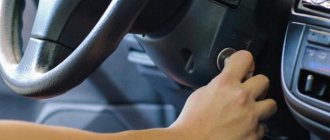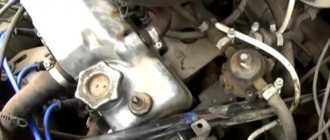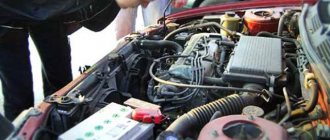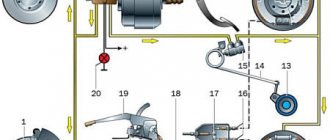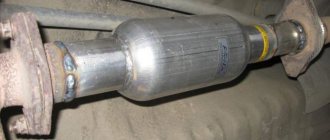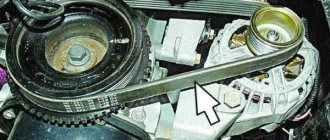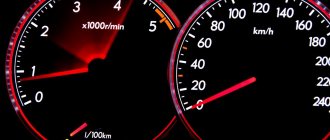Many different mechanisms and systems are involved in the correct operation of the car’s power unit. They are all connected in one way or another. The failure of one of them has a significant impact on the functioning of the engine. Hence, sometimes there is a feeling of unusualness from the fact that the failure of any part leads to problems in the operation of the motor. One of these problems is that the engine stalls when you sharply press the gas. It sounds somehow unnatural. This article will help you understand why this happens.
Causes of malfunction
This problem can appear on any car with any type of power unit, and, worst of all, it happens at the most inopportune moment. There are quite a few reasons for such a breakdown, and not all of them can be diagnosed. Of all the possible reasons, it is worth highlighting several main ones, the diagnosis of which can be carried out independently. These are the faults:
- vehicle engine ignition systems;
- fuel supply system and its tightness;
- electronic sensors and power unit control unit.
It is in these nodes that the culprit of this trouble lies. It is more convenient to carry out diagnostics at a specialized stand; it will much faster identify a specific faulty part that can be changed to restore the car’s performance. If it is not possible to use special equipment, you can carry out diagnostics yourself, armed with the advice in this article.
Throttle valve
Very often the engine stops because of the throttle. This happens due to contamination of its surface, which in turn occurs due to a malfunction of the air filter. You should also make sure that the position sensor (one of the variable resistors, which is installed on the damper axis) is in good condition.
How to be
: The problem can be quickly resolved by simply cleaning the inside of the throttle body. If the position sensor is broken, it will need to be replaced. The replacement procedure takes a couple of minutes. All spare parts are cheap.
How to check the ignition
Problems with this system have very different manifestations. It often happens that at idle everything works fine, but as soon as you increase the speed by pressing the pedal, the car immediately stalls. Very often this is due to an insufficiently strong spark between the spark plug electrodes. The reason may be worn spark plugs and poor insulation of high-voltage wires. Checking the spark plugs is quite simple: at the moment when the engine stalls, unscrew them and look at the condition of the electrodes.
They should be clean and have a slight reddish tint; if this is not the case, and there is a black coating on them, and even more so wet traces with the smell of gasoline, then it’s all about them or high-voltage wires.
A weak spark is not able to ignite an increased amount of fuel while pressing the gas, and it simply goes out, so the power unit stops working. The wires are well checked in the dark. To do this, you need to start the engine, and the places where the insulation is damaged will immediately be visible; current discharges break through them. Experienced drivers always have a set of spark plugs and wires in reserve, this helps to quickly change them and continue driving.
If the spark plugs and wires are in order, the fault should be looked for in other components or parts of the engine.
Why does the VAZ-2112 stall while driving?
Car : VAZ-2112. Asks : Roman Sitnikov. The essence of the issue : The car stalls while driving.
Hello! I have this problem. When I'm driving, the car suddenly stalls, and after a while it can be started again and continue on my way. At the same time, it works great when cold, no comments. But in a traffic jam, when I accelerate and brake, such situations occur, and sometimes the “check” light comes on. Tell me, please, what could be the reason?
How to check fuel supply
The fuel system has quite a few parts that can fail at any time or cannot cope with the increased load on the engine when you press the gas pedal. The car may stall due to insufficient supply of gasoline to the combustion chamber. Initially, it is worth checking the operation of the pump. This can be done by connecting a monometer to it and applying power.
A working pump will produce a pressure of 2.7 atmospheres; a slight deviation upward or downward of a few tenths of an atmosphere is allowed.
If the monometer shows a significantly lower number, the pump is faulty and needs to be replaced. Often the fault lies in the injectors that spray gasoline into the combustion chamber. They fail due to low-quality fuel, the impurity particles of which contaminate their nozzles. The injectors can only be checked at a specialized stand. Only he can determine their correct operation. It is possible to independently identify the malfunction only in the case of a completely broken injector.
To do this, the ramp with injectors is unscrewed and removed from the engine, the nozzles are moved away from the engine, and the starter is turned on.
The fuel from the nozzles should begin to spray; if this is not the case, and gasoline flows out or drips, such nozzles must be replaced.
Poor atomization can lead to failures in the operation of the power unit or its complete stop.
The filter is also of great importance in the fuel system. Very often, its filter elements become clogged when using low-quality gasoline. And it is no longer able to pass a sufficient amount of fuel through itself when the car must gain speed while pressing the gas pedal. You can check the condition of the filter using a monometer, which is connected to the outlet fitting. On an unclogged filter it should show about 2.7 atmospheres, plus or minus two tenths. If the monometer shows less, then the filter needs to be changed, because of it the car behaves this way.
Some fuel system malfunctions involve incorrect operation of the system pressure regulator. It is not able to provide the required pressure when the load and engine speed increase, so the car stalls when you give gas. A faulty pressure regulator manifests itself in unstable operation of the power unit, both at idle and while the vehicle is moving. Check it yourself by connecting a monometer, having first removed the vacuum tube from the regulator.
With the engine idling, we look at the pressure gauge. It should show no less than 2.7 and no more than 3.8 bar, depending on the car. If the pressure remains at the minimum value, the regulator is faulty and fuel begins to flow back into the gas tank.
A fairly rare breakdown, but one that has a strong impact on engine performance, is a clogged drain tube of the gas tank filler neck and its cap. In this case, a vacuum, that is, a vacuum, is gradually created in the gas tank, and the fuel supply to the engine stops. This may cause the car to stall while driving.
To check it yourself, just unscrew the tank cap at the moment when the car stalls and try to start it.
If this is successful, then the drain tube needs to be cleaned and the fuel tank cap needs to be replaced.
Messages 9
1 Topic by psiva 2013-08-18 22:35:14
- psiva
- New member
- Inactive
- Registration: 2013-08-18
- Messages: 8 Thanks : 0
- Car: VAZ 2111
Topic: when I lightly press the gas the rpms drop and the car stalls
Hello everyone! I have a VAZ 2111 16kl injector January 5.1 and I have this problem, the car works fine on xx, everything is fine in diagnostics too, but when you lightly press the gas the speed drops and the car stalls, if you press the gas sharply then everything is fine, replacing the IAC did not help I reflashed the ECU, it didn’t help, but it got better, it mostly happens when it’s hot. What could be the problem?
2 Reply from igorek 2013-08-18 23:49:00
- igorek
- Brother-in-law
- Inactive
- From: Bryansk region g Starodub
- Registration: 2013-05-05
- Messages: 416 Thanks : 191
- Car: VAZ-21102 1.5i-8V Bosch MP7.0H
Re: when you lightly press the gas, the revs drop and the car stalls
In words and seeing it’s difficult to help, I’ll say one thing I read on the forum, one little man described his problem, she became chondril, not childish, she became stupid, as if someone was holding her by the ass, he went to the diagnostics at the stand, everything is fine, all the sensors are working, but in the end the car doesn’t drive; diagnostics sealed the car; they didn’t do it I went to another car service, the same thing the master says, most likely the air flow sensor masovog chondrites buys it puts in the end nothing has changed minus 2500 from Corman plus 600 rubles for diagnostics I went to the 3rd car service such a picture everything is normal everything is fine but the car is stupid and here -300 r from Corman, in general, he writes, he was driving to another city, he came across the same road car service center, a guy who looked 24 years old stopped by and told him his trouble, he grinned and said, let’s see, he takes out an ordinary control and starts poking it into the degnostic block, the owner is horrified, saying, what are you poking there? it’s not a carburetor, it’s an injector, he grinned and said, I don’t understand you, should you make a car or not, and began to move on and then got out of the solon and told the owner to start the creek and drive by, he started it, and in shock, the car came to life, stopped being stupid, he asked him what he was doing I did it, he says, I went to 3 specialized services, I visited the problem, I didn’t eliminate it, he grinned and said the mass on the controller was bad, he screwed up and draw all the conclusions, but you got a porno from him for repairs of 150 rubles without such specialists in our car service center.
Source
Gasoline supply device tightness
Its tightness plays a major role in the correct functioning of the power unit. This is achieved by using gaskets. One of the reasons why it stops working after pressing the gas pedal is excess air intake due to a leak in the intake manifold gasket.
As a result, the necessary vacuum is not created in the intake manifold, and the balance of the fuel mixture is disrupted. Excessive air intake into gasoline makes the mixture too lean, which is why the car stalls when you give it gas.
This breakdown can only be detected at a specialized stand.
This malfunction can also occur as a result of a burnt-out cylinder head gasket, as a result of which coolant enters the combustion chamber and the engine begins to stall after pressing the pedal. The ingress of liquid into the cylinders can be determined by the state of the exhaust gases. If white smoke comes out of the muffler pipe during re-gassing, very similar to steam from a kettle, this means that the gasket has lost its tightness and it is necessary to carry out work to replace it.
Messages 9
1 Topic by psiva 2013-08-18 22:35:14
- psiva
- New member
- Inactive
- Registration: 2013-08-18
- Messages: 8 Thanks : 0
- Car: VAZ 2111
Topic: when I lightly press the gas the rpms drop and the car stalls
Hello everyone! I have a VAZ 2111 16kl injector January 5.1 and I have this problem, the car works fine on xx, everything is fine in diagnostics too, but when you lightly press the gas the speed drops and the car stalls, if you press the gas sharply then everything is fine, replacing the IAC did not help I reflashed the ECU, it didn’t help, but it got better, it mostly happens when it’s hot. What could be the problem?
2 Reply from igorek 2013-08-18 23:49:00
- igorek
- Brother-in-law
- Inactive
- From: Bryansk region g Starodub
- Registration: 2013-05-05
- Messages: 416 Thanks : 191
- Car: VAZ-21102 1.5i-8V Bosch MP7.0H
Re: when you lightly press the gas, the revs drop and the car stalls
In words and seeing it’s difficult to help, I’ll say one thing I read on the forum, one little man described his problem, she became chondril, not childish, she became stupid, as if someone was holding her by the ass, he went to the diagnostics at the stand, everything is fine, all the sensors are working, but in the end the car doesn’t drive; diagnostics sealed the car; they didn’t do it I went to another car service, the same thing the master says, most likely the air flow sensor masovog chondrites buys it puts in the end nothing has changed minus 2500 from Corman plus 600 rubles for diagnostics I went to the 3rd car service such a picture everything is normal everything is fine but the car is stupid and here -300 r from Corman, in general, he writes, he was driving to another city, he came across the same road car service center, a guy who looked 24 years old stopped by and told him his trouble, he grinned and said, let’s see, he takes out an ordinary control and starts poking it into the degnostic block, the owner is horrified, saying, what are you poking there? it’s not a carburetor, it’s an injector, he grinned and said, I don’t understand you, should you make a car or not, and began to move on and then got out of the solon and told the owner to start the creek and drive by, he started it, and in shock, the car came to life, stopped being stupid, he asked him what he was doing I did it, he says, I went to 3 specialized services, I visited the problem, I didn’t eliminate it, he grinned and said the mass on the controller was bad, he screwed up and draw all the conclusions, but you got a porno from him for repairs of 150 rubles without such specialists in our car service center.
Electronics malfunction
In modern cars, the entire operation of the engine is controlled by an electronic unit (ECU), which selects the optimal option under different load conditions. The ECU selects the correct mode based on the readings of various sensors; it reads many parameters from the power unit.
The nature of the malfunction indicates the failure of the following elements:
- A throttle position sensor, which must execute the command received from the ECU when the crankshaft speed increases and adjust the throttle position to lean the fuel mixture. If this does not happen, the engine stalls.
- Mass air flow sensor. It must regulate the flow of air into gasoline to achieve the mixture of the required flammability. When it is broken, the mixture cannot be adjusted and the car stalls.
- The coolant temperature sensor, which transmits the incorrect temperature to the ECU, as a result of which the computer does not allow the power unit to gain increased speed and stops it.
The correctness of the indicators of these parts can only be determined using diagnostic equipment. It is possible to fix the damage yourself only by replacing them step by step.
Checking the fuel pump
The main indicator of the performance of the fuel pump is the gasoline pressure in the fuel rail. Methods of connecting to the fuel line:
- using a standard fitting to measure pressure in the rail. This type of power system is installed on VAZ 8-valve internal combustion engines with a fuel return line from the rack to the gas tank. You can connect the pressure gauge through an adapter that screws onto a fitting with an external thread. Inside the fitting there is a spool valve, reminiscent of a bicycle valve, which, when pressed, communicates with the fuel rail and pressure gauge hose. But not all cars have a factory connector for connecting a pressure gauge. And in some cases the adapter itself is more difficult to find than to make a device for direct connection;
- connection contrary to the fuel line. You will need: a pressure gauge with a measurement scale of up to 7 kg/cm², a fuel hose of a suitable diameter, a tee and 2 fittings (“male” and “female” quick-release type) for connecting standard pipes. Such a simple device will allow you to crash into the fuel line, while maintaining the ability to start the engine.
There are a large number of ready-made kits for measuring fuel pressure in the rail on sale. But purchasing it is not practical for one-time use. The high cost is due to the many different fittings and adapters for connecting to the main types of power systems. If you are considering purchasing such a kit, make sure that it has the necessary adapters to connect to your car.
>>>> Ideas for life | NOVATE.RU
5. Fuel filter It doesn’t matter what the driver owns - a VAZ or a foreign car. All cars, without exception, crash “just as well” due to problems with the fuel filter. Most often, such a disaster happened to really old models that had been in service for more than a year. The engine stalls due to interruptions in the fuel supply, which, in turn, begins due to a dirty filter.
How to be
: It is necessary to remove the fuel pump and replace the filter. Check the bank for blockages. If there is one, clean the fuel tank to avoid a quick recurrence of the problem.
Carburetor adjustment
Carburetor adjustment consists of several stages:
- Adjust the float position as described above.
- Check and tighten the “quality” and “quantity” screws. Screw them in until they stop and unscrew 2-3 turns for a “quality” screw and 3-4 turns for a “quantitative” screw.”
- Connect a tachometer or auto tester to the “K” terminal of the ignition coil, and the second sensor to the body.
- Start and warm up the engine to 90°C
- Use a “quality” screw to set the maximum speed to the minimum. Gasoline consumption is increased by turning the screw counterclockwise.
- Use the "amount" screw to increase the speed by about 80-90 rpm.
- Using a high-quality screw, we determine whether these speeds are maximum; if not, we repeat the procedure.
- If the position of the adjusting screw does not affect the engine speed, tighten the quality control screw until the speed drops to 800-900 rpm.
This carburetor adjustment may not be entirely accurate, but does not require special equipment.
Fuel quality
Don't forget that the quality of the fuel you fill can directly affect the quality of the fuel you fill. Some cars and engines are not allowed to use certain types of fuel at all. Therefore, we monitor and remember what we pour into the tank.
How to be
: Empty the gas tank and replace the fuel filter if the vehicle has already started to stall due to fuel. After this, try to fill only the necessary fuel of the appropriate quality level.
Ozone or Solex
With the start of production of the VAZ 2108 and 2109, AvtoVAZ designers abandoned the use of Ozone carburetors, in which many complex options had no practical meaning. What was the cost of the forced idle economizer alone, which supposedly served to save fuel during engine braking? Neither engine braking became widespread, nor did the EPKH bring any noticeable savings, but it provided drivers with quite a few headaches when pressing the gas.
When switching to “eights” and “nines”, the plant returned to a simpler version of the carburetor. It was distributed under the name Solex: after the name of the French company that produced its prototype. Solex lost the pneumatic drive for the secondary chamber damper, a semi-automatic starting device, and an autonomous idle system.
The design has been simplified and reliability has increased. It is Solex that, as a rule, owners of carburetor versions of the VAZ 2109 deal with.

